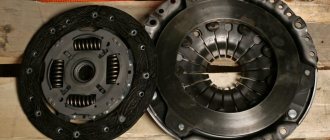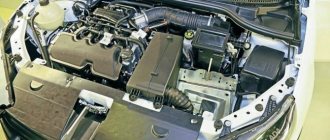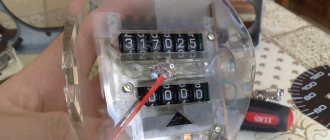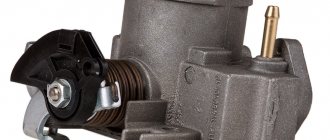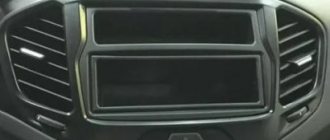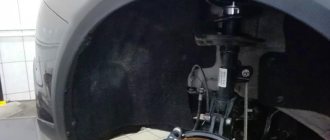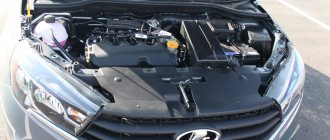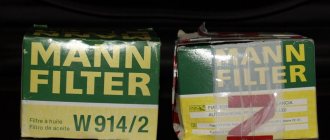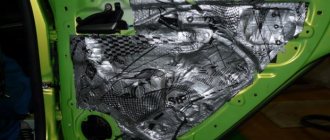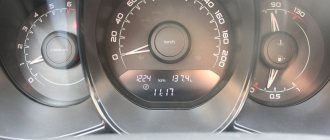Mileage Lada Vesta
Problems with high mileage cars
On Russian roads you can already find a Lada Vesta with a mileage of 100,000 km. Over a long period of driving, certain problems will certainly appear, and the need for minimal maintenance will arise. Based on reviews from Vesta owners, we can draw conclusions about its typical problems and general condition at different stages of operation.
It is clear that two cars with the same mileage may have different conditions. It depends on the driving conditions (city or highway) and the quality of the road surface. And it’s difficult to say exactly at what mileage this or that breakdown appears - everything wears out differently. So the problems listed below will not necessarily arise on your car.
Gearbox
Closer to 15,000 km, problems with the manual transmission may occur: extraneous sounds and sticking gears.
The “robot” Lada Vesta, which is called one of the main disadvantages of this car, does not perform well during operation. This includes noise, delayed gear shifting, and even gearbox failure.
On a note!
Some motorists notice that sometimes the shortcomings of the Lada Vesta gearbox disappear after changing the oil filled at the factory.
Mileage Lada Vesta
Lada Vesta has been tested for durability: what will happen to the car after 150 thousand kilometers?
“Lada Vesta” has been maintaining popularity on the Russian market for many months and does not give up the title of the most popular product in the domestic automobile industry.
There are many reasons for this, ranging from its affordable cost to its attractive exterior and adaptability to harsh Russian winters. In the price category to which Vesta belongs, it is difficult to find a car that would offer the same level of power, safety and comfort. But what will happen to the car if you drive it 150 thousand kilometers? Will everyone's favorite stand the test of time and distance? We have found a copy that will answer this question! The car, which will allow us to assess the condition of the well-travelled Lada Vesta, belongs to a friend of mine. He “earned” such an impressive mileage in the most literal sense of the word: the car was used for work. The car belongs to a courier who drove it around the city five times a week for two years. The Vesta was practically never driven outside the city limits, so this is an excellent example of the changes that occur to a car during long-term use in urban conditions. Over the course of many months of use, the car was not overly carefully cared for, but quite sufficient - in accordance with all requirements. Every 10 thousand kilometers the oil and filter were changed, every 15-20 thousand kilometers other consumables were changed. At the same time, no special anti-corrosion treatments or other additional measures were carried out that were not included in the list of mandatory ones. Source data: Lada Vesta with a 1.6-liter engine and a manual transmission. A proven and reliable option. How long will it remain like this? Upon first inspection of the car, it is immediately noticeable that two years of continuous operation have not affected it too much. For example, unlike Korean cars, the Vesta hood, although it does not look “like new,” is not covered with an abundance of scratches and chips. Damage can only be noticed if you look closely. The usual cursory glance notices not a new, but a very decent car in good condition. After 150,000 kilometers, it's better than expected. If the chips that form on the hood are painted over in a timely manner, then problems with corrosion should not arise. The same applies to all other parts of the body. If you take care of the car at least to a minimum and paint slopes and cracks regularly, the car will last for many years without falling apart from rust. The hard plastic used in the Vesta’s interior usually causes negative impressions. But in this case it fully justifies its use. Neither an external inspection nor a study of the interior allows one to guess what the actual mileage of the car is. Both outside and inside, Vesta looks much newer. All plastic elements remained in good condition, even the steering wheel did not need to be replaced. If you are the first owner of a car, this is a definite plus! But when buying a Lada Vesta on the secondary market, you need to be careful. Such preservation makes it easy to misrepresent the mileage and pass off a car as younger than it actually is. But crickets and squeaks as you move will still reveal the truth. When driving on bad roads, various sounds accompany every movement of a domestic car, especially since Vesta, alas, cannot boast of impeccable build quality. However, relative to other AvtoVAZ models, Vesta has made a huge step forward.
As for the contents of the engine compartment, everything is in full accordance with the regulations. After 110 thousand kilometers, as expected, the clutch was replaced. At the same time, the experts checked the suspension. The engine and gearbox operate stably. No unnecessary noise or other problems were identified during operation. The only thing worth paying attention to is that after 60 thousand kilometers, the car owner decided to remove the catalyst and replace it with a “dummy” one. This helped reduce fuel consumption, and the car became noticeably more lively when driving. Overall, I was pleasantly pleased with Vesta - after two years and 150 thousand kilometers, it remains in very good condition. The model is definitely suitable for long and active use. You can also buy it on the secondary market if normal maintenance and replacement of all components and consumables required by regulations has been carried out. What you should be careful with are models equipped with a robotic gearbox. The first couple of years they produced not very successful robotic gearboxes, and reviews from owners of Vesta with a “robot” were mostly negative. Nowadays, transmissions have improved significantly, but manual transmissions are still the most reliable and stable option.
Body
In most cases, Lada Vesta owners have no complaints about the quality of the paintwork, much less the protection of body elements from corrosion. But some of its parts may still not withstand the influence of the external environment, namely:
- Roof, because it has the least protection against rust.
- Front bumper paint that is chipped off by gravel. Fortunately, this element is made of plastic and is not subject to corrosion, but its peeling appearance clearly does not decorate it. The rear bumper coating at the points of contact with the trunk lid also wears out quickly.
Problems with high mileage of a car Rust may appear on metal parts in the engine compartment, because... Due to the loose fit of the hood lid, a lot of dirt and moisture gets there.
Important!
To avoid serious system breakdowns, undergo timely maintenance of your Lada Vesta. Specialists will replace fluids and check the wear of car parts.
This is how much I spent on my Lada Vesta in two years and 150 thousand km
Review of the Lada Vesta car (2017)
I want to tell you about my Vesta, which I bought in 2021 for 650 thousand rubles. The car is equipped with Comfort Multimedia with a 1.6 engine and an AMT gearbox. So, in order. I'll start with the positives.
1. Appearance. I think almost everyone here will agree that Vesta is one of the most beautiful cars in this segment.
2. The price is significantly lower than that of competitors. For some reason everyone says that Vesta is crazy expensive, but this is far from true. For that kind of money, for example, Rio and Solaris will be naked (possibly with air conditioning). In normal configuration, Solaris-Rio will cost you 900 thousand.
3. Vesta is very cheap and easy to maintain; for example, good quality brake pads cost only 600 rubles.
4. Car thieves are not interested in the car due to cheap spare parts. Accordingly, the cost of CASCO is not high.
5. Standard sound insulation is better than that of competitors.
6. Security. Finally, AvtoVAZ has started installing subframes on its cars; by the way, the maximum configuration includes four airbags.
7. Body. Two years ago I caught the threshold on a curb and wore it down to metal, I didn’t bother doing it, it’s already the third winter season and there’s not even a hint of rust. The body is galvanized.
8. Suspension. In 150 thousand km I have never touched the suspension.
1. Reliability. Whatever one may say, all the units except the suspension remained from AvtoVAZ, all the sores have not gone away, but if you do not skimp on consumables, then the car will serve you faithfully
2. Brand reputation. People still make fun of the cars we make, but usually the people making fun of them are those who don't have a car at all. Of course, this is AvtoVAZ’s jamb due to its early quality. AvtoVAZ will continue to gain trust and love for the brand for a long time to come.
3. Painting quality. The body does not rot, but is susceptible to chips and scratches. After 30 thousand km, the hood is completely chipped.
4. The robot on the Lada is very crude, dull, and takes a long time to switch, but over time you get used to it.
Now let's talk about how much it costs to own this car.
1. Fuel consumption. The 1.6 engine on the robot eats quite a lot: in the combined cycle I get 11.2 liters. With a fuel cost of 42 rubles per liter and a mileage of 150,000 km, I spent 705 thousand rubles.
— I changed the pads three times, they cost 600 rubles, and the brake discs twice cost 4,000 rubles. The cost of brake system work for three times is 700 rubles. Total for the brake system is 11,900 rubles.
— OSAGO: 8,000 rubles per year, for two years 16,000 rubles.
— I filled the oil from a barrel, since there are fewer fakes from a barrel. I have never had it checked by a dealer, because I think it’s stupid to pour Rosneft and change it every 15,000 km. I change the oil strictly every 10,000 km. The cost of replacement (labor + oil + filter) 2500*15 is only 37,500 rubles.
— The timing belt was changed twice along with the pump. I consider this a consumable cost: 5,000 rubles for a kit plus 5,000 rubles for labor, twice - only 20,000 rubles.
— A set of winter tires costs 15,000 rubles, plus two seasons of installation for a thousand each. Total 17,000 rubles.
- Windshield. Unfortunately, windshields can be counted as consumables, 10,000 rubles (glass + replacement).
— Clutch. On the robot, the clutch is very weak. I changed it twice: 7,000 rubles for the set plus 7,000 rubles for labor, for a total of 28,000 rubles.
— Robot actuator. Once it failed for me, unfortunately this is also a weak point: 14,000 rubles for the actuator plus 2,000 rubles for labor - a total of 16,000 rubles.
— Resonator. The corrugation died. I installed the entire resonator with reinforced corrugation: 3000 for the resonator itself + 1500 for labor - a total of 4500 rubles.
— Antifreeze tank. The antifreeze tank burst on the road: 500 rubles for the tank, 100 rubles for the cap, plus replacement 500 rubles - a total of 1100 rubles.
Rest
Owner reviews also cover the following points:
- the durability of the standard jack leaves much to be desired - it fails even with infrequent use;
- sometimes scratches appear on the windows of the driver and passenger - all because of the velvet and sand accumulated there;
- with the onset of cold weather, many complain about weak windshield heating;
- crickets may occur in the cabin;
- wheel caps are often lost;
- The antenna mount breaks.
BEHIND THE STEEL
In April 2016, a car was purchased, which became the subject of our close attention 20 months later, when its mileage counter measured the first hundred thousand kilometers.
All these months, Vesta did not sit for a day, and after its owner agreed to our diagnostics with passion and until the time of writing this material, it drove another 8861 km, its total mileage was no less than 108.
According to the owner, Vesta was initially purchased as a workhorse for every day. Family, new, BMW X6 and Mitsubishi Outlander, due to the characteristics of their operation, did not pass this casting, primarily due to their fastidiousness to service. There were also doubts about Vesta. After all, this is a new VAZ product with the expected set of “childhood diseases”. But the simplicity of the design and unpretentiousness in maintenance did their job - a new warranty car from AvtoVAZ appeared in Ilya’s fleet.
However, the car was not under warranty for long, only until the first maintenance, after which the owner, who had driven the required 15,000 km on the Vesta by that time, came to the conclusion that the dealer service station where the car was purchased, to put it mildly, “doesn’t work.” He did not correctly inform us of the true reasons for the divorce from the branded service, but further maintenance work on Lada was carried out without reference to the dealer service station. And this, according to the owner, turned out to be many advantages both for him and for the car.
Thus, the “Rosneft” oil recommended by VAZ was replaced by “synthetic” Total 5W-40, Knecht filters were “prescribed” in the oil system and the air supply system to the cylinders, and at a mileage of 45,000 km, the factory brake pads, which were pretty much “eating up” the front brakes, were replaced wheels, Spanish Remsa arrived. At the same time, maintenance procedures were carried out, as they say, in fact, at a variety of service stations. The simple and reliable 16-valve VAZ 106-horsepower engine never required special attention; the suspension and the chassis as a whole endured all the hardships and hardships of merciless operation. When I met the owner, the car had 98,000 km on it, and he smiled and said that there was nothing special to tell.
Like, the actual consumption of the car on the highway is about 7.0 l/100 km, in the city - 8.5-9.0 l/100 km. The suspension is a little soft; at high speeds the car begins to “float” on the road. There are no problems with sound insulation or corrosion, especially considering how much the car cost. There were no repairs, just maintenance and tire changes.
Not a lot, to be honest. Another 2000 km, which was not enough to reach the 100,000th threshold, finally printed out a list of car faults. At 99 thousand, the right front stabilizer mounting bracket cracked. The malfunction was eliminated by banal metal welding followed by cleaning. At the same time, rubber bushings on the stabilizer have been replaced by polyurethane ones, which do not cause squeaks during large suspension strokes. One of the rubber muffler hangers also required replacement, but the Vesta owner is not offended by it, since it failed after hitting an obstacle. Both repairs are simple and, in fact, cheap.
After a run of 100,000 km, the timing drive mechanism and the cooling system pump were preventively replaced on the car. The factory recommends doing this procedure at 180,000 km; at 90,000 km only a careful inspection of the mechanism is provided, but the owner decided otherwise. All parts and consumables were purchased through official channels, and the service itself, including timing belt replacement, was done by an alternative service station specializing in VAZ engines. Also, plastic tubes that regulate the operation of the intake manifold required replacement. Over the course of a year, the factory ones cracked and became unusable.
At the same time, the brake mechanisms of the front and rear wheels were subjected to close attention. The reason was almost complete wear of the front brake discs and pads. The latter ran 10,000 km more than the factory ones, that is, 55,000 km.
An examination of the rear drum brake mechanisms showed that the wear there was much less significant, only 1.5 mm, but these millimeters created many problems when removing the drums, after which the resulting shoulder was removed. It also turned out that the mechanism for adjusting the gaps in the rear brakes, a la Renault, requires at least thorough cleaning. At the same time, it was decided to replace the rear brake pads, again with Remsa products.
This is where the list of work and costs for the Lada Vesta, which ran 108,861 km, ended. Ahead of the car there was a thorough diagnosis of the chassis and body at an independent service station and a dyno, which was supposed to dot the i's in terms of the well-being of the power unit, which, by the way, unlike its 1.8-liter brother throughout the entire 108,000 km of run did not “eat up” a drop of oil.
An hour spent on a lift for the Lada Vesta and the actual diagnostics of the car's chassis showed that Vesta deservedly receives good reviews from its owners. Dry shock absorbers, “live” balls, intact boots, no-loose steering - this is the short verdict after a meticulous inspection of the car’s chassis. Under the hood is dirty, but also dry, no hints of oil fogging or other drips. It’s as if the car doesn’t have 108,000 km behind it.
But, as happens with any used car, there were some unpleasant surprises. The first stumbling point is the corrugation of the exhaust system. Vesta has this weak point, and “our” car, alas, was no exception to the rule. The defect can be “cured” either by replacement at a branded service station, very preferably under warranty, since not only the corrugation is replaced, but also part of the muffler for a very substantial amount (about 180 USD), or simply by replacing the corrugation at an alternative service station, where 20 USD .e. a good corrugation costs 20 USD. - work to replace it.
The second point, or rather points, are pockets of corrosion on the outside of the front part of the rear wheel arches. Despite the additional anti-corrosion treatment done at the dealer, they are present here on both the driver's and passenger's sides. And in a good way, the outbreaks that have arisen need to be opened and painted, since the Lada Vesta is not an Audi A8, its metal is of Russian origin. And I would strongly recommend that buyers and owners of new Vesta protect these places with armored film, as many Renault Duster owners do. And then stones from under the front wheels will not cause damage to the paintwork and body.
